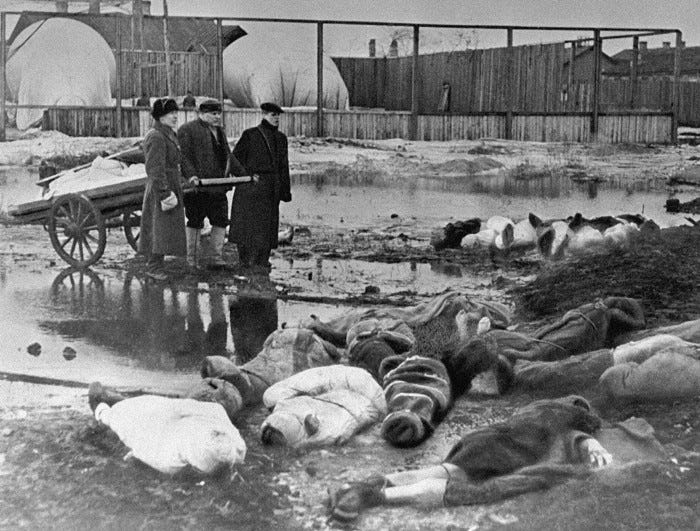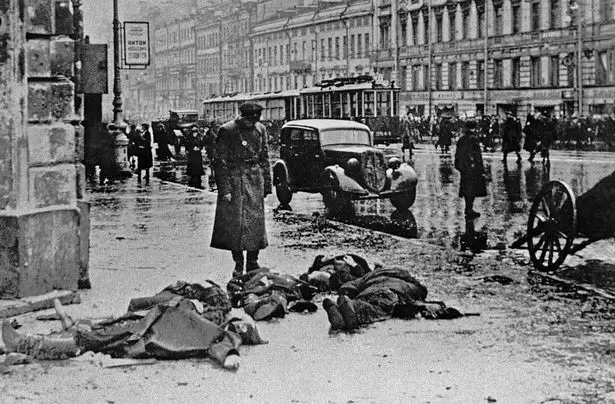(Disclaimer: This article contains images and information that can affect you emotionally, reader’s discretion is advised)
 ith Operation Barbarossa putting the German Army at full speed, the Soviet army protecting Leningrad had no chance to fight back. This was something that the Germans have taken into account and decided to besiege the city. Knowing that rations are scares it was only a matter of time before the troops and citizens of Leningrad would surrender or die of hunger.
ith Operation Barbarossa putting the German Army at full speed, the Soviet army protecting Leningrad had no chance to fight back. This was something that the Germans have taken into account and decided to besiege the city. Knowing that rations are scares it was only a matter of time before the troops and citizens of Leningrad would surrender or die of hunger.
Besides the hunger that literally drove people crazy to the point of murdering other poor souls under the same predicament to steal their food rations, there was a huge moral drop from being constantly bombarded by the Germans. The below-freezing temperatures reaching even -40 degrees celsius didn’t help the situation either.
The siege began on September 8, 1941, the day the German army completed the maneuvers to encircle the city. In his lightning war against Moscow, which he wanted to conquer, Hitler decided to bypass Leningrad and besiege it, destroying it by exhaustion rather than wasting soldiers with a direct attack. With no reinforcements, the Soviet troops within Leningrad knew that their best strategy is defending until any reinforcements would come to liberate them.
Alexis Peri who is a history professor from Boston University found new documents justifying the atrocious conditions during the siege of Leningrad whilst researching old Russian archives. All of the following information is taken from his discoveries.
One of the harshest winters
By the end of September 1941 gas and coal resources were running low, and on Christmas eve that year the whole city run out of heat. Almost at the end of the year, the water pipes froze and broke, leaving people without drinking water.
People first started to burn the kitchen shelves as there was no food to put in them anyway, then they burned the kitchen tables for the same reason. Once they burned most of their remaining clothes they would also burn their wardrobe as it has no use anymore just to stay warm. The last thing was the most priced possession, the family library as noted in some old archives by Alexandra and Vladimir Dyen.

Slowly, due to lack of food and heat, people began to die. Over 11,000 in November, then in December almost 53,000 with the number doubling each passing month. Because of the frozen ground, people could not even bury their dead. The bodies were therefore collected on the streets of the city, in parks, and in other open areas. To these daily torments of the locals were added the attacks of the Germans, who bombed Leningrad every day.
Hunger as the worst Enemy
By the end of September 1941 gas and coal resources were running low, and on Christmas eve that year the whole city run out of heat. Almost at the end of the year, the water pipes froze and broke, leaving people without drinking water.

The food supply suffered from the beginning of the war, at that point, it became a critical problem. By November, rations were already 1/3 of the daily food intake recommended for an adult. Dogs, cats, horses, rats, and even crows were decreasing day by day, the animals reaching the tables of the lucky ones who managed to catch them before being snatched by someone else.

People reached such a poor mental condition from the hunger that they would kill random people on the street to take their food ration cards, whilst hiding the bodies in their homes for a brief moment of craziness where they would have the guts to turn cannibalistic. From all the various books written by former Soviet historians, all mention the cannibalism that took place all over the Soviet Union due to extreme hunger.
So great is the despair of a hungry person…that you would not think twice before eating the leg of a human corpse. The archives found by Peri show clear evidence of people turning to eat the dead. A human can go without food for 21 days at best. The siege lasted for 900 days so you can imagine the situation those people were facing.
The archives mention that around 1,500 citizens from Leningrad had been arrested for cannibalism during the siege. However, it is assumed that a bigger number of people have turned to cannibalism during this period of time and only a small number were caught.
There have been two types of cannibalism identified in this situation. The first were those who would eat corpses that had already passed away from hunger. The second type was those who would kill other people just to eat their flesh.
We cannot judge those who have turned to cannibalism as hunger can make one’s state of mind go insane, especially when in the late stages of hunger you start experiencing hallucinations. Tell me you would not go insane when your body is starting to consume your own muscle tissue in order to survive, just thinking about it would give any person shivers.

The mental torment of being hungry, cold, exhausted physically, mentally, and emotionally whilst being bombed day and night is something that no history book can describe. When the survival instincts kick in supported by your body’s desperation, no person can hold back their own insanity.

When winter came in 1942, despite all its difficulties, the citizens still had hope. Lake Ladoga located in the east of the city froze completely and created the possibility of transporting food and other supplies on ice. The road was also used as an escape route for those who wanted to leave. The rest received slightly higher food rations, and the situation in the city stabilized.
People continued to die, even in large numbers, but even after almost 872 days, Leningrad did not give up. Then, in January 1944, the Red Army came in aid and managed to push the Germans beyond the city limits. Despite a great win after 3 years of devastation, over 800,000 people from Leningrad died during the siege, most of them dying from hunger.
Avid Writer with invaluable knowledge of Humanity!
Upcoming historian with over 30 million views online.
“You make your own life.”





